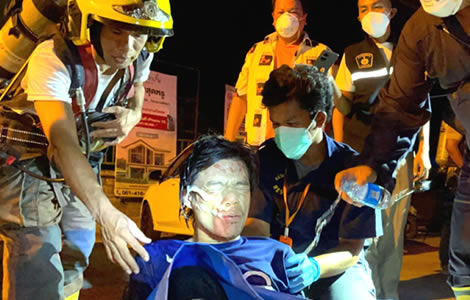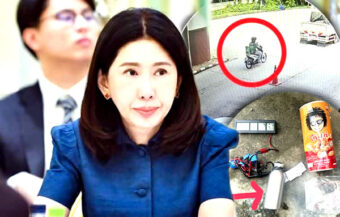Emergency averted in Pattaya as 60 suffer from ammonia leak. Quick response contained the crisis. Ammonia leak at a Nong Prue ice factory caused 60 to cough blood and foam at the mouth. Fast action by rescue teams, an evacuation order and the closure of the ammonia source could have averted a major calamity and saved lives.
A well-organised disaster and emergency response in Chonburi early on Thursday morning may have prevented a greater calamity. As it was, an explosion of ammonia gas from opened valves at a refrigeration plant in Nong Prue in the Bang Lamung area of Pattaya on Thursday morning saw at least 60 people coughing blood and foaming at the mouth. Subsequently, a 1 km radius of evacuation was ordered while emergency responders with gas masks accessed the factory and managed to switch off the ammonia leak at the Racha Ice Factory.

A disaster in the Bang Lamung area of Chonburi near Pattaya was declared early on Thursday morning. The Bang Lamung district chief called in emergency services. They included rescue units and the army. It came after what some locals described as a powerful explosion at a local refrigerating plant in Nong Prue.
However, afterwards, a director of the firm denied that an explosion had occurred.
60 people reportedly suffered coughing fits which saw blood emitted as they also foamed at the mouth amid a deep cloud of ammonia in the air near the plant
Nonetheless, up to 60 people including residents, tourists and workers at the facility were left violently stricken.
They coughed up blood and foamed at the mouth as ammonia gas expelled itself from the factory’s disrupted production system.
In short, the leak is understood to have been caused by a ruptured pipeline.
This situation lasted from 11.30 pm on Wednesday night until 12.40 am on Thursday morning.
Emergency responders using army equipment including masks previously accessed the factory and closed off the ammonia valves.
141 people were hospitalised at seven local hospitals. Three are still reported to be serious while 126 were reported as having suffered green or less severe injuries.
The ammonia leak occurred at the Racha Ice Factory in Nong Prue, Bang Lamung District, Chonburi Province. In brief, it led to 141 people being hospitalised.
Fortunately, most people were not seriously injured in the disaster which saw a massive response from emergency rescue crews, the army and volunteer units
Fortunately, most were in a less serious condition. The emergency saw seven different hospitals in Chonburi take in patients.
Pattaya City Hospital handled the biggest number. At the same time, up to 300 different rescue crew members took part in an effective local disaster response.
It was later confirmed that the factory, known for producing ice for various uses, experienced a severe leak of ammonia.
At length, this is the chemical commonly used in refrigeration processes. In the open air on Thursday morning, however, it caused distress and chaos for workers and residents in the locality.
The incident was reported around 11:30 pm.
Consequently, a disaster plan was put into action. This led to a response from the Nong Prue Municipality Disaster Prevention and Mitigation Centre.
Rescue teams from the Sawang Boriboon Foundation, Pattaya City, and other nearby rescue units arrived at the scene. They swiftly assessed the situation and provided assistance.
Large dense clouds of ammonia surrounded the local facility some 3 to 4 metres from the ground. People were found vomiting and in seizures due to its effects
Upon arrival, officials found a large cloud of white smoke, approximately 3 to 4 metres high. In short, it was emitting a strong ammonia odour.
Inhaling ammonia causes a burning sensation in the throat, suffocation, and severe eye irritation. More than 60 people suffered from vomiting.
At the same time, they also showed signs of blood and foam around the mouth. The severity of the leak prompted the evacuation of individuals within a 1-kilometre radius of the factory.
This order was given by Mr Weekit Manarojkit, the Bang Lamung district chief. He was given a briefing by emergency services regarding the factory leak. The premises concerned are located at No. 54 Chaiphonwithi Road in the Nong Prue district.
Mr Weekit ordered an evacuation of all properties within 1 km of the Racha Ice Factory. This included local businesses and a residential estate where hundreds of families were sleeping.
Firefighters wearing masks the heroes of the hour
A team of firefighters, equipped with SCBA suits, oxygen masks, and backpacks, along with factory technicians, worked to close the valves on the ammonia tanks. These were part of the Public Disaster Mitigation Centre.
The valves were eventually secured. Officials confirmed the situation was brought under control by 12:40 am. The team also sprayed large quantities of water to dilute the ammonia present in the air.
Bang Lamung District Chief, Mr Weekit, established an incident command centre approximately 1 kilometre from the factory.
Afterwards, he confirmed he had ordered the evacuation of people in the vicinity to ensure their safety. A community hall was opened for residents who did not feel safe returning to their homes immediately.
Rescue teams had meanwhile evacuated residents from nearby areas.
Hundreds of families evacuated from their homes on Thursday morning until the disaster was declared over and the area once again safe from the toxic gas
This included the Ua-Athorn Village Project, where hundreds of families live. Certainly, emergency workers later identified more than 100 villagers who were affected by the ammonia leak. They received immediate first aid.
A witness, Ms Chan, a 45-year-old noodle vendor, described the moment of the incident. She heard a loud explosion that shook the ground for nearly a minute. Afterwards, she observed a large cloud of white smoke rise from the factory. Recognizing the smell as ammonia, she immediately fled the area, fearing for her life.
Ms Chan noted that while such leaks had occurred in the past, this one was far more severe.
Factory executive, Mr Boonanant Pattanasin, acknowledged the leak.
Factory boss denied that there had been an explosion. However, he did accept that something went wrong
In short, he denied any explosion. He clarified that the ammonia leak likely resulted from damaged pipe equipment and caused panic among the factory’s workers
Mr Boonanant offered a sincere apology for the incident. Similarly, he promised to take care of all victims and their expenses. He expressed gratitude to the rescue teams for their timely assistance. Nevertheless, he did emphasise that ammonia leaks do not cause explosions.
The injured were treated at various hospitals across the area, with preliminary reports indicating 129 green cases (minor injuries), 9 yellow cases (moderate injuries), and 3 red cases (severe injuries). Victims were distributed to hospitals in Pattaya City, Jomtien, Laem Chabang, and other nearby areas.
Public Health minister ordered a report prepared for the Prime Minister’s Office while the disaster is another warning about Thailand’s industrial safety standards
As authorities continue to monitor the situation, the Public Health Minister Dr Cholnan Srikaew ordered a comprehensive assessment. He asked officials to closely monitor the incident. He pointed out that a report on what happened must be sent on to the Prime Minister’s Office.
While the situation has been brought under control, the aftermath of the ammonia leak serves as yet another wake-up call.
It serves as a stark reminder of the potential hazards within Thailand’s industrial sector. It comes just a week after a still unresolved cadmium scare with 13,450 tons of the deadly substance going missing from Tak province.
Significantly, some of this load, linked to Chinese industry, is still missing while officials have found other disturbing aspects. For instance, at least one site was connected to the water drainage system in Bangkok’s Bang Sue district.
At the same time, it has been confirmed that the people living near one of the factories storing the substance have tested positive for high toxicity levels.
Even before the evolving cadmium controversy and indeed scandal, an explosion at Suphan Buri in January which claimed 23 lives still awaits real answers
Even before that, there was a disaster in Suphan Buri in January. This was when a fireworks factory exploded killing all 23 people at the facility.
The facility was so fundamental, it had no machinery. All the work was done by hand. The explosion completely obliterated the plant leaving nothing in its wake. 23 people died.
At that time, Industry Minister Pimpatra Wichaikul ordered an investigation. Ms Pimpatra is currently in the midst of the cadmium crisis. This incident in Bang Lamung, Chonburi is yet another warning that all is not right with industrial safety.
Split-second decision saved mother’s life at Suphan Buri fireworks plant which claimed 23 lives mid-week
Catastrophe in Suphan Buri as at least 22 die in huge fireworks explosion on Wednesday afternoon
Lethal Cadmium linked to a shift in dangerous e-waste recycling from China to Thailand since 2017
The only consolation and indeed positive from Thursday morning’s incident was the effective disaster response in Chonburi from local authorities. In truth, they may have averted a real disaster.
Ammonia is a dangerous substance and can stay in the air for approximately one week.
Certainly, it is fatal in sufficient quantities and interacts with the skin. It can also cause lung damage.
Although widely used in refrigeration, it has been banned in Canada since 1999. This is due to its toxic nature.
Join the Thai News forum, follow Thai Examiner on Facebook here
Receive all our stories as they come out on Telegram here
Follow Thai Examiner here
Further reading:
Threat from contaminated fruit and vegetables from China part of a wider problem facing the kingdom
Bank of Thailand holding strong against quite a strident push by the PM for more populist economics
Digital Wallet plan blown out of the water by corruption body on Tuesday warning of illegality
Economy is in troubled waters with fears for both exports and foreign tourism as 2023 winds down
Thailand faces an economic future of low growth despite Srettha’s plans because of a darker world
Another dip for the baht or are economic danger signals flashing for both Thailand and the world?
Bank of Thailand boss appears critical of the new government’s policy initiatives on the economy
Concerns over household debt rising as banks report marginally lower non-performing loans
Thailand preparing for a soft landing as ‘cracks’ open up in the Chinese economy says bank chief


















